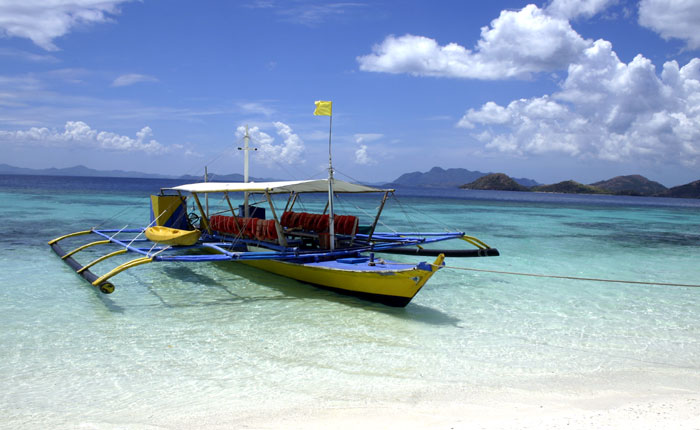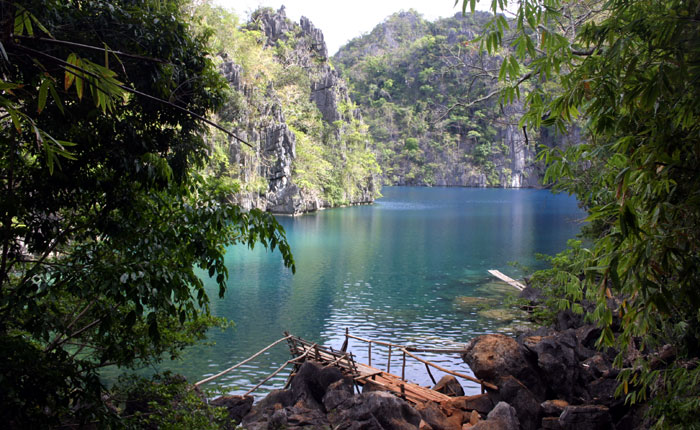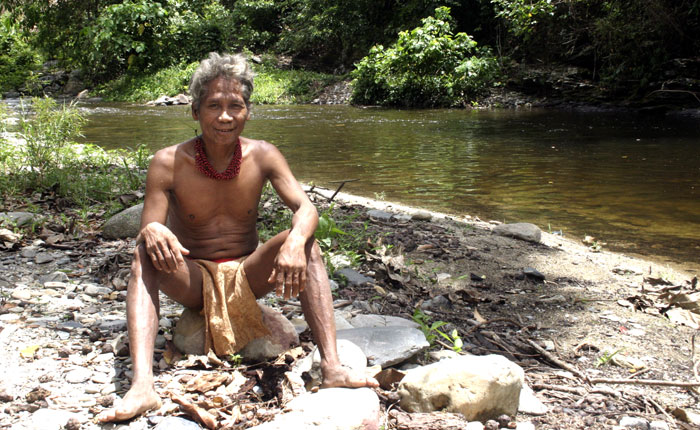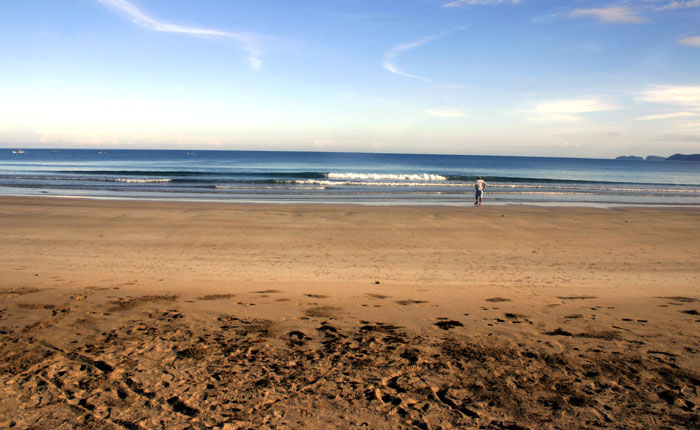Forget Melatonin. I’ve found the cure for jetlag.
It took 14 hours, three planes and a sweaty night in a beach bungalow. But at 8.30 am local time, juddering along on the front of an outrigger, my feet dangling either side of the bows, spray kicking in my eyes, I felt wired - even if it was 1am back home. Mix in a few tunes on the iPod and but for the serious danger of falling overboard I'd have danced.
 They may look a little rickety but these brightly painted outriggers have a fair lick of speed when they get going.
They may look a little rickety but these brightly painted outriggers have a fair lick of speed when they get going.Closer to China and Japan than the rest of South East Asia, The Philippines is harder to get to than say Thailand or Vietnam. There are no direct flights from the UK. You need to fly via Hong Kong, the Middle East or Amsterdam; so it takes a bit of effort and it costs more.
But that’s part of the reason for going. There’s hardly anyone else there. If you’ve tired of teenagers with Rough Guides and neck charms, and internet cafes on every street corner, then it could be just what you’re looking for.
Palawan province, a bundle of islands an hour’s flight south west of the capital Manila is perfect for some real exploration. It’s like Thailand 20 years ago: gorgeous, hawker-free beaches, genuinely friendly locals, cheap as chips seafood and fantastic diving and snorkelling. The hordes will doubtless get there soon and my advice is to go now whilst you can still have much of the place to yourself.
 The locals on these islands really are incredibly friendly. And the kids just loving having their photo taken!
The locals on these islands really are incredibly friendly. And the kids just loving having their photo taken!Even at 8.30am the sun was hot. My white Northern Hemisphere skin felt like a huge solar panel soaking up its energy. We sped on between islands and pearl fields, flying fish frolicked in front of the bows. Nearby, fishermen plopped their single-hooked lines over the sides of their tiny boats.
Despite the howl of the outrigger’s engine there was a sense of tranquillity. And I was about to swap the noisy surge of boat for the regular hush and spurt of air beneath the glassy surface of the sea.
Palawan is the main island in the province, but I started my trip among a cluster of islands a little way north called the Calamianes. Their tiny coves and bays seemed like the perfect hiding place for a fleet of Japanese warships during the Second World War. Unfortunately for the Japanese the Americans got wind of them and sank the lot.
There are upwards of 15 wrecks buried beneath the azure waters offering some of the most varied wreck diving you'll find anywhere. The Kogyo Mara is an old freighter lying on its side at 25 metres.
It had been a while since I’d dived and I was nervous as I tugged on my wetsuit. Thomas my German diving instructor was a man of few words. It didn’t help matters that I managed to put my foot through the sleeve of the wetsuit. Getting it back out was not easy. I tried to cover my embarrassment as I hopped and tugged with a throw away laugh. It sounded just a little hollow.
After I’d got over a bout of hyperventilations, which Thomas politely ignored, he led me slowly down the long rope from the marker buoy on the surface. As the undersea world swallowed me in its cool embrace, my anxieties abated. Huge grouper fish looked on impassively as we finned along the rusty fuselage. Bright bat and banana fish flitted around the clumps of lunar coral that clung to the rusty decks.
The anti-aircraft guns on the foredeck were clearly visible. A swim-through into the bridge and out the other side gave us a glimpse of the gaping hole into the hold where a bomb had torn the heart out of the ship and sent it to its watery resting place.
 The clear-water coves of the Calamaine islands are littered with sunken wrecks. It's spectacular diving territory.
The clear-water coves of the Calamaine islands are littered with sunken wrecks. It's spectacular diving territory.I dived again that afternoon. But not in the sea. Nearby Coron Island has a hidden lake. You scramble up a rickety staircase and over craggy volcanic chunks of rock with your tank on your back, fins in hand. It's hard work and very ungainly. Deep blue on the surface, Barracuda Lake looks like the ultimate secret swimming hole.
We flopped into the water and rested after the climb. Then we slowly descended into the depths. Suddenly my wetsuit began to warm up. And no, I hadn't had a bladder malfunction. At first it was like being in a hot tub, delightful. Then the heat rose. My vision went blurry. My senses were playing tricks. My face mask wasn't steamed up but I could hardly see a thing. The water was treacly, clinging to me like Ghostbuster ectoplasm. Strange streaks of darker liquid sat in layers around me.
Just as the heat seemed unbearable, my feet hit chilly water. It was the strangest sensation as the water in my wetsuit went from cold to hot to cold again. A seam of hot thick volcanic water sits down here at about 20 metres and you can swim along with your legs in the heat and your head in the cool.
There's little fish-life. Thomas showed me a cave that disappeared into blackness. Somewhere out there was the sea. The theory goes that small fish get through from the sea, but can't find their way back. Most die in the muggy waters. But some survive and grow unfeasibly large in their captive tank. Somewhere in these murky depths lives the giant barracuda of Barracuda Lake.
Well, that's the legend. I'm glad Thomas told me once we returned to the sunshine on the surface.
 This place could be straight out of The Beach. A totally hidden lake surrounded by steep limestone cliffs.
This place could be straight out of The Beach. A totally hidden lake surrounded by steep limestone cliffs.Read more > A walk on the wild side in Albania
If you're not into diving you can get hold of kayak and paddle around a string of tiny coves on Coron, many sheltered from the sea by saw-toothed crags and bottomed with sparkling coral. Make sure to take a snorkel. There's another small wreck at only around six metres on aptly named Skeleton Beach surrounded by schools of rainbow-coloured fish.
Several of the coves are quite hidden, suddenly appearing around the corner of rocky outcrops. Twin lagoon has a swim-through tunnel. I felt like Leonardo DiCaprio in The Beach finding my own hidden paradise as I took a deep breath and plunged through. I floated on my back in complete solitude watching the flashes of bright plumage as kingfishers dipped into the water and out again. Alex Garland may have set his book in Thailand but he lived in the Philippines – maybe this very place was the inspiration for his story.
It might be paradise now, but Palawan was the last place any self respecting urban Filipino would have visited a few decades ago. It was here that native tribes still practiced head-hunting and sorcery. These days many of the 16 tribes that live on the main island Palawan, have become westernised, but not all of them.
The stories that the locals told me in the provincial capital Puerta Princesa seemed a touch far fetched. The Tau Batu are cave dwellers. It takes seven days' trekking to reach them and they are frightened of outsiders. They apparently hold tinned sardines in great reverence, as a sign of wealth. They use the tomato sauce as conditioner for their hair. The Ba'tak tribe feast on squirrels and worms and are fearsome warriors.
I set out with Josep my guide to meet the Ba'tak, armed with a large bag of chocolate, cigarettes, coffee and sweets in the hope that they'd give me a friendly welcome.
 Rafael was still smiling even though I managed to break his prize bow.
Rafael was still smiling even though I managed to break his prize bow.Their village didn't look much different from any other. It had taken a couple of hours of sweaty trekking to reach it. Josep was put out to see that the tribe had installed corrugated aluminium roofs on their huts. A gift from the local governor, they made the whole place look a lot less 'authentic'. The villagers were all wearing jeans and T-shirts too.
We chatted to Lito the head of the tribe. He explained that many of their old ways of life are threatened by eco-legislation. Slash and burn agriculture for growing rice is no longer allowed. Increasingly they can't retain their nomadic lifestyle as areas of the rainforest are designated off-limits.
Rafael one of the elders showed me his bow and arrow which he uses to hunt wild boar and squirrels. Before I knew it he was proffering it to me. I needed to show my hunting skills to gain their respect. My first arrow dropped off the end of the bow to howls of laughter. For my second, I pulled the sting back as far as I could. And it snapped. I'd broken the head hunter's bow. Things were not looking good.
To cover my embarrassment, the tribe said they'd show me their monthly fertility dance. Josep suggested I tip them some cash as a thank you. Fair enough I thought.
The next thing I know most of the women are walking around bare-chested. There are boobs everywhere. I don't know which way to look. We wander down to the riverside where the women set up a rudimentary tree trunk drum and bash it with sticks whilst two of the younger kids demonstrate warrior dances with pretend swords.
The girls are then asked to dance too. One is clearly embarrassed about her state of undress. I still can't decide if the tribe really do this dance each full moon as I was informed or whether it's a ploy to get tourists to visit and cough up cash for the bare-chested ladies. It all felt a bit staged, but then it was. Who was exploiting who? I've no idea.
Read more > Meet the pillage people in Denmark
My Palawan experience ended at the province's biggest tourist attraction; the St Paul's Subterranean River – a huge network of watery tunnels deep inside a limestone mountain. To reach it requires a dusty, bouncing drive from Puerta Princesa across to the opposite coast of Palawan.
Sabang, near the entrance of the river is a sleepy little place of shack shops, beach bungalows and fishing boats. Oh, and there's also a long sandy beach fringed with coconut palms and hardly anyone else around.
I flopped into the blood-warm surf after a gritty day of driving. My bungalow was basic but clean, though the dripping pipe in the bathroom that stood for a shower was a tad disappointing. The barbecued jackfish with coconut milk and seaweed in vinegar and garlic I ate in their little restaurant was some of the best food I'd tasted. Washed down with a couple of local San Miguel beers I decided they had the priorities right.
 Turn the torches off inside the St Paul's underground river and it's totally, utterly dark. Completely disorientating.
Turn the torches off inside the St Paul's underground river and it's totally, utterly dark. Completely disorientating.I awoke next day to the sound of waves breaking on the sand. Outside beyond a sentry group of palms was that perfect beach and it was absolutely empty. After another swim we jumped aboard an outrigger to hop around a couple of bays to the underground river. After donning helmet and life jacket we clambered into another boat complete with guide and hand held torch powered by huge car batteries.
We paddled off slowly across a lagoon to the entrance: a low roofed cave. There's no lighting inside these water filled tunnels. Within moments it was virtually pitch, our torch illuminating just a shallow circle of light ahead. The air filled with midges which got in my nose and eyes making me blink and cough. Swallows dipped and chirped above us catching them on the wing. Our guide pointed out the strange stalactites and stalagmites around us, huge lumps of mud-brown rock glistening with tiny beads of crystal.
Eventually we reached a huge anti-chamber called the Cathedral. This far into the dank network of tunnels it's too dark for swallows to fly around without bumping into things. But bats are quite at home. Hordes twitched and fidgeted in clumps on the rock above us in the light of the torch. Suddenly a whole swarm would come screeching away and disappear back into the darkness. The tunnels continue for nearly 6 miles, but tourists turn back after a mile or so.
That evening I sat on the beach, another cold beer in hand nobody else around again and watched the sun dip slowly into the sea. The Philippines might have its bare-chested ladies, its watery wrecks, its bat-filled tunnels and giant barracudas, but the best thing about it is the sense of complete escape, of perfect tranquility and space.
As the world gets ever smaller, these cherished moments becoming increasingly rare: well worth the long journey and the jetlag any day of the week.
 Particularly first thing in the morning the beach is yours at Sabang. Just you and the waves lapping at your feet.
Particularly first thing in the morning the beach is yours at Sabang. Just you and the waves lapping at your feet.Start planning your Philippines holiday
Get There: Fly direct from London to Manila with Philippine Airlines. Qatar Airways flies via Doha; Emirates via Dubai; British Airways via Hong Kong or Bangkok.
Local airline Cebu Pacific Air connects Manila with Busuanga (Coron) and Puerto Princesa (Palawan).
Stay There:
For the Calamaines Divelink and sister resort Coral Bay offer well equipped bungalows and great food. They also arrange snorkelling, kayaking and diving.
Dive Calamaines in Coron town offers day and liveaboard trips.
Do The Tour: Local operator Marsman Drysdale offers a range tours on Palawan. UK operators offering Palawan include Audley Travel.
Find Out More: The Official Philippines Tourist Board website.
The Palawan local tourist information website.